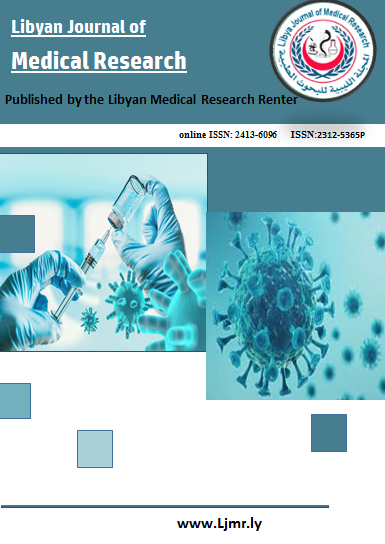PREVELANCE OF CESAREAN SECTION AND IT’S RELATED FACTORS IN SUBRATA HOSPITA, LIBYA
DOI:
https://doi.org/10.54361/LJM19.1.14Keywords:
cesarean sections, age, height,, breech presentation, fetal distress, deliveryAbstract
This study aims to identify the prevalence of cesarean sections at Subrata Hospital and assess the relationship between cesarean deliveries and factors such as maternal age, maternal height, breech presentation, and fetal distress. A cross-sectional study was conducted involving 118 mothers who delivered either via cesarean section or normal delivery in Subrata Hospital from June 1, 2024, to July 31, 2024. The study utilized universal sampling and analyzed data from medical records using descriptive statistics and the T- test for association through SPSS software. The study found that 50% of deliveries were cesarean sections. Age analysis showed that 46% of participants were older than 35, and this group had a statistically significant association with increased cesarean rates (p = 0.030). Additionally, 64% of mothers were under 150 cm in height, which was associated with a higher likelihood of cesarean delivery (p = 0.034). Fetal distress was present in 38% of cases, showing a significant link to cesarean delivery (p = 0.032). Breech presentation was noted in 50% of cases, though this did not show a significant statistical difference regarding the mode of delivery (p > 0.05). The research highlights a significant association between maternal age, maternal height, and fetal distress with cesarean deliveries in Subrata Hospital. Monitoring these factors may help optimize delivery outcomes. The study recommends improving maternal health strategies focusing on age and height and ensuring adequate preparation for cases involving fetal distress or breech presentations.
Downloads
References
World Health Organization. World Health Organization guidelines on cesarean section. World Health Organization Report. 2004.
Smith G. Cesarean section rate appears to rise with maternal age. Cambridge University Press, UK; 2008.
Scott RT, Hankins GD. Maternal height as a risk factor for cesarean section. Am J Obstet Gynecol. 2001;225:659-664.
Nalliah S. Report summarizing breech presentation study. Breech Presentation, USA; 2001.
Timothy P, Dennis J. Cesarean section for fetal distress. Am J Obstet Gynecol. 2001;11:241-244.
Belizan JM, Althabe F, Barros FC, Alexander S. Rates and implications of cesarean section in Latin America: Ecological study. BMJ. 1999;319:1397-1399.
Hannah W, Chance GW. Final statement of the panel of the National Consensus Conference on Aspects of Cesarean Birth. Can Med Assoc J. 2002;122:41-52.
Goer H. Rising trend of cesarean section. Aust N Z J Obstet Gynaecol. 2001;12(3):20-27
Masterson S. Cesarean section facts and fiction. Am J Obstet Gynecol. 2004;200:213-220.
Gabbe S, Niebyl J, Simpson JL. Normal and problem pregnancies. 5th ed. New York: [Publisher]; 2007. Chapter 19.
Anderson A, Thomas E. Assisted vaginal delivery versus cesarean section. Life Sci Wkly. 1999;84(6):588-592.
Sanghiv R, William J, Richard R. Vaginal delivery versus cesarean section in breech presentation. J Fam Pract. 2000;19(4):1385-1390.
Smith G. Cesarean section rate appears to rise with maternal age. Cambridge University Press, UK; 2008.
Wesley F, Elfving B. Definition of fetal distress. Wiley Intersci J. 2000;81:200-205.
Bontrager K. Fetal distress. Labor & Fetal Distress. [Publisher]; 2003. Chapter.
Williams J, Colman S. Women’s guide to better birth. London: [Publisher]; 2000. Chapters 1, 2, 7.
Merchant KM, Zanini A. Normal delivery versus cesarean section. Can Med Assoc J. 2001;140:12-15.
Downloads
Published
Issue
Section
License
Copyright (c) 2025 Mawia. M.Beshti , Asarya A. Abo elghaith (Author)

This work is licensed under a Creative Commons Attribution-NonCommercial-NoDerivatives 4.0 International License.
Open Access Policy
Libyan journal of medical Research (LJMR).is an open journal, therefore there are no fees required for downloading any publication from the journal website by authors, readers, and institution.
The journal applies the license of CC BY (a Creative Commons Attribution 4.0 International license). This license allows authors to keep ownership f the copyright of their papers. But this license permits any user to download , print out, extract, reuse, archive, and distribute the article, so long as appropriate credit is given to the authors and the source of the work.
The license ensures that the article will be available as widely as possible and that the article can be included in any scientific archive.
Editorial Policy
The publication of an article in a peer reviewed journal is an essential model for Libyan journal of medical Research (LJMR). It is necessary to agree upon standards of expected ethical behavior for all parties involved in the act of publishing: the author, the journal editorial, the peer reviewer and the publisher.
Any manuscript or substantial parts of it, submitted to the journal must not be under consideration by any other journal. In general, the manuscript should not have already been published in any journal or other citable form, although it may have been deposited on a preprint server. Authors are required to ensure that no material submitted as part of a manuscript infringes existing copyrights, or the rights of a third party.
Authorship Policy
The manuscript authorship should be limited to those who have made a significant contribution and intellectual input to the research submitted to the journal, including design, performance, interpretation of the reported study, and writing the manuscript. All those who have made significant contributions should be listed as co-authors.
Others who have participated in certain substantive aspects of the manuscript but without intellectual input should only be recognized in the acknowledgements section of the manuscript. Also, one of the authors should be selected as the corresponding author to communicate with the journal and approve the final version of the manuscript for publication in the LJMR.
Peer-review Policy
- All the manuscripts submitted to LJMR will be subjected to the double-blinded peer-review process;
- The manuscript will be reviewed by two suitable experts in the respective subject area.
- Reports of all the reviewers will be considered while deciding on acceptance/revision or rejection of a manuscript.
- Editor-In-Chief will make the final decision, based on the reviewer’s comments.
- Editor-In-Chief can ask one or more advisory board members for their suggestions upon a manuscript, before making the final decision.
- Associate editor and review editors provide administrative support to maintain the integrity of the peer-review process.
- In case, authors challenge the editor’s negative decision with suitable arguments, the manuscript can be sent to one more reviewer and the final decision will be made based upon his recommendations.














